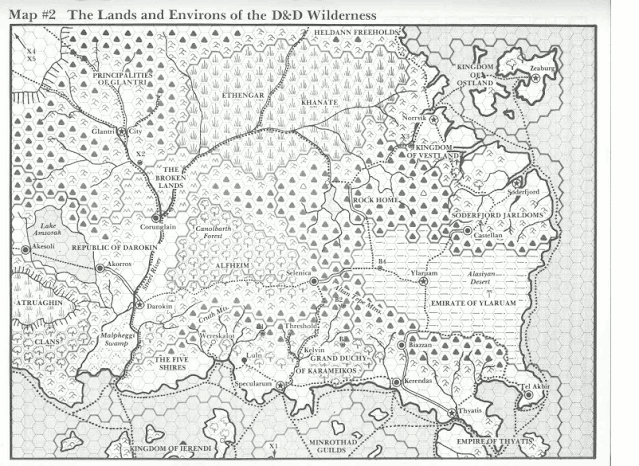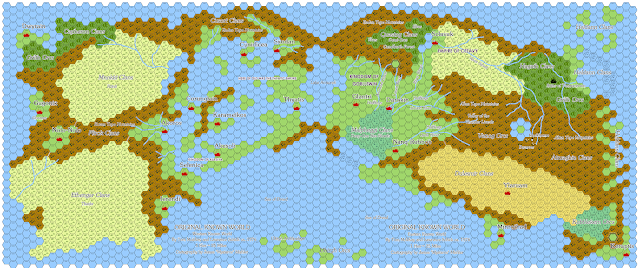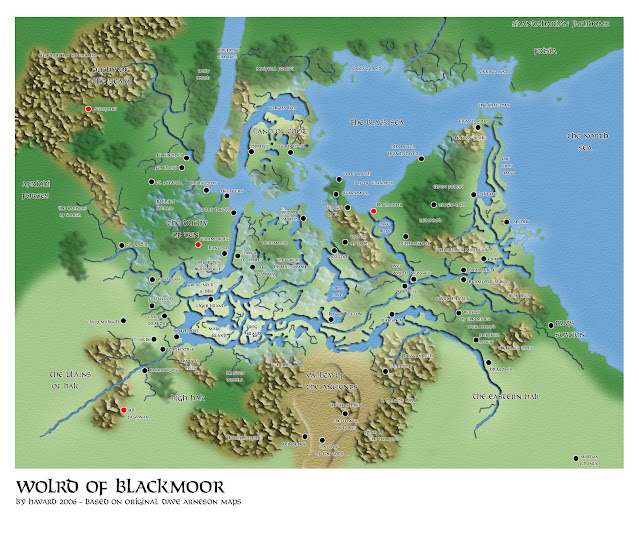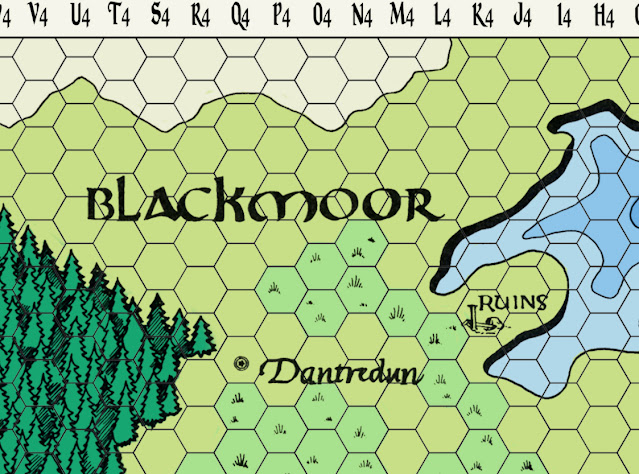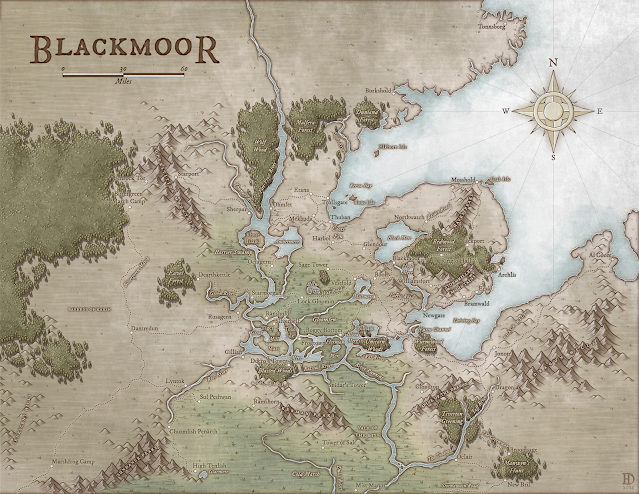I have been meaning to spend some quality time in Calidar lately. If you have been reading this blog for a while you know that I am a fan of the work of former TSR writer and editor,
Bruce Heard. A few years back he began producing some system-neutral books for his
World of Calidar. A world situated around the Great Caldera and the planets in the same solar system. If you recall Bruce's work on Mystara and in particular his "Voyages of the
Princess Ark", then you can see how this is a logical progression of similar ideas.
I have reviewed other Calidar books in the past, in particular
Calidar, In Stranger Skies and
Calidar, Beyond the Skies. I figure this is a good week to cover some of the other books.
Bruce himself has been discussing his books and how they all work together on
his own blog, so you can read that there.
Today I want to start with one of my favorites Calidar projects.
Calidar On Wings of Darkness.
CAL2 Calidar On Wings of Darkness
134 pages, Hardcover, Softcover, and PDF. Full-color covers. Color and black & white art interior.
For this review, I am considering the PDF and softcover versions I received
via the Kickstarter.
The book is broken up into the following chapters/sections.
A Mage's Conundrum: This is the fiction piece that sets the stage for what readers (and players) can encounter in Caldwen, this country of Mages and Demons.
History of Caldwen: This chapter covers the time-line of Caldwen and the moon of Munaan where magic comes from. We learn of early dealing with demons and the start of the mages. Presented in timeline format we are given over 7000 years of history to the present day of the campaign.
Lay of the Land: In this chapter, we are treated to some full-color maps which are always a strong feature of all the Calidar books. Here, of course, we are focused on the Magiocracy of Caldwen. Now it is natural to make comparisons between Caldwen and Bruce's other magiocracy, the Principalities of Glantri. Yes there are some similarities, but there are plenty of differences too. The main difference comes from the geography of the land, and the sea. Caldwen is a coastal country with over two-thirds of its borders coasts. In some ways I get a solids 7th Sea vibe here and this feels more Age of Sail than it does the dark ages. I have to admit that while D&D is firmly on my mind as the system of choice for this, I can help read it over and think that
Mage: The Sorcerers Crusade would also be a REALLY good fit for this.
We get a two-page, detailed map with legend. Again, great cartography from Thorfin Tait.
The nine Provinces (with one Dominion) follow after this in "Gazeteer-like" formats. We get details on each province and local maps. The area of the whole country is huge and boasts over 10 million inhabitants. Just looking at the maps gives me plenty of ideas!
Intrigues of the Magi: This chapter covers the politics of a country that is a magiocracy, a meritocracy, and a dascalocracy. Or one that is ruled by meritorious teaching mages.
This chapter also covers the social structure for these wizards and how the various Provinces interact as part of the central government. Though the central government might be overstating it since much power lies in the rulers of the Provinces. We see some of the few stat blocks here and they are given in the Calidar shorthand stats. They can be translated into your game of choice using the
Game Mechanics for the World of Calidar book (which is PWYW).
Behind the Curtains: Deals with the various non-mage guilds that also keep Caldwen moving. They are a mixed lot and would work well in any game. I would tend to use them more as background or NPCs, not so much as guilds for PCs to join.
A Cast of Many: The NPCs of note in Caldwen. Again stats are presented in the Calidar stats but easily converted to any game. Mentally I found myself inserting Pathfinder and D&D5 stats where needed and with a little more thought could see Mage: TSC stats as well.
This section is also heavily hypertexted. So if someone else's name appears in an NPC entry you can click it to go to their entry. The same is true for titles, colleges and other items.
Some stand out like Kryovata the Icy, a gnome sorceress and leader of the Protectors.
Master & Servant: Caldwen has a fair number of demons running around. These are bound demons and under the control (in theory) of a mage. This chapter covers demons, their ownership and the pacts created. Also, the demonic Black Market is discussed. Like the previous chapter, this has notable demons detailed.
Beasties in the Dark: The monster section of some of Caldwen's more interesting creatures. Detailed in the same stat system as the rest of the book.
At the Heart of Magic: Ah. Now here is the meat of the book. This covers Caldwen's schools of magic and how their benefits, tuition, philosophies, diplomas, and campus rivalries influence the fabric of the entire magiocracy. The magic schools are treated as colleges and have a similar feel to the American and British collegiate system. We also learn of two of the sports played, Dracoderby which is like a dragon polo and Pugminton. Magic use in game is expected.
Each college is detailed and which town and Province their seat is in. The colleges are Abjuration, Alteration, Conjuration, Divination, Enchantment, Illusion, Invocation, Necromancy, and Grand Wizardry.
Circles of Wizardy are given, roughly levels of academic attainment. First (Undergrad) to Fourth (Doctorate). Like all good colleges, there is also outplacement and career counseling. Sure you want to be a Ruler? Maybe the Path of Adventurers is a better choice for someone with your grades?
Secrets of the Cabals: What's a wizard's life without Secret Cabals? Not a life at all! Here we learn of the various cabals that cover the "Wizard's Guild" of most other settings. The cabals cover Alchemy, Demonology, Dracology, Elementalism, Necromancy, and Skymastery, with their attendant tests, abilities and philosophies.
Blood of the World Soul: This covers the raw magical force, Mana, that makes Caldwen so special. If you are familiar with
ley lines or the Radiance from Glantri then you have an idea here. It also details the order assigned to protect this mana.
Sky City of Arcanial: Now this is the stuff I love. Floating cities are something I just never get enough of, to be honest. Arcanial is the home of the High Wizard Chancellor's palace, the ministries, embassies, the Great Library, and the College of Grand Wizardry. Plus all the private dwellings of the Caldwen's Rich and Famous. And you need flying gondolas to get up to it! How cool is that?
There are wonderful, full-color maps of the city and plenty of details. This is the sort of thing I keep coming back to Calidar for. I mean really. If your fantasy game does not have a floating city in it are you even playing fantasy?
The entire book is bookmarked and hyperlinked (PDF version only obviously) and a treat to flip through. There are so many ideas packed into this book I am unsure where I would start.
There is a lot packed into these 134 pages and there is a lot more that could have been said, but Heard wisely leaves that for you to do.
Adapting to any game is easy, though there is a strong AD&D 2nd Ed or BECMI D&D vibe here. Maybe that is just me though since I have been liberally mixing my Mystara with Calidar for a while now. Long, long time readers might recall that in my games there was a revolution in my Glantri and now it is a Theocracy. Caldwen allows me to have my cake and eat it too. I can keep "my" Glantri as is complete with the it's French Revolution-style revolt, AND still have a cool country of mages, wizards and a magic school.
I am serious. A Caldwen + Mage The Sorcerers Crusade game would be a lot of fun.
I'll look in to this more when I cover the next Caldwen (Bruce's "Series Two") book,
CA2 How to Train Your Wizard.


